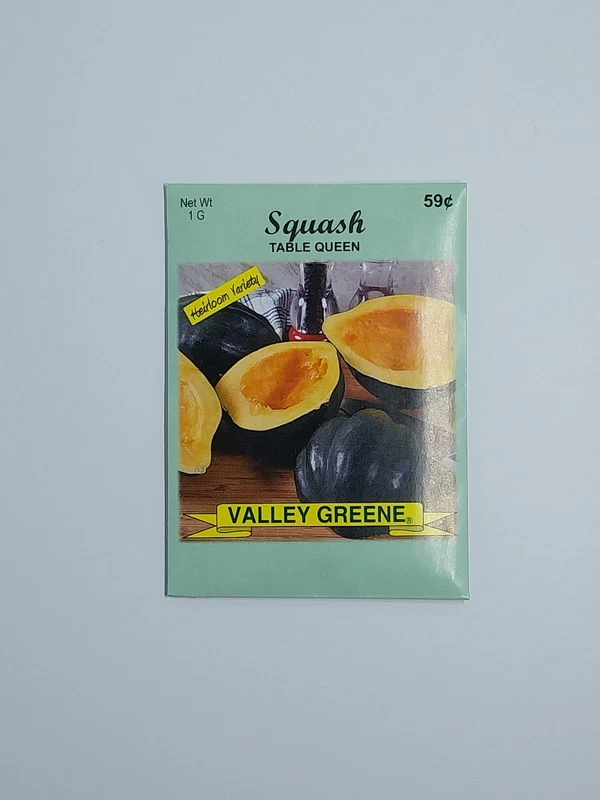Valley Greene Squash Table Queen Exp 12/2025 1G Seeds – Must-Have for Gardeners
Ships from
Indonesia

Shipping options
Estimated to arrive by Thu, Jul 24th.
Details
This estimate is based on:
- The seller's handling time
- USPS Ground Advantage (1 to 10 business days) transit time to US
Actual delivery times may vary.
Have shipping questions? Contact the seller
$3.11 via USPS Ground Advantage (1 to 10 business days) to United States
Ships from
Indonesia

Offer policy
OBO - Seller accepts offers on this item.
Details
You can make your offer during the checkout process as long as you do not live in a state where marketplace facilitator tax laws exist.
Check your state.
Payment options
PayPal accepted
PayPal Credit accepted
Venmo accepted
PayPal, MasterCard, Visa, Discover, and American Express accepted
Maestro accepted
Amazon Pay accepted
Nuvei accepted
Shipping options
Estimated to arrive by Thu, Jul 24th.
Details
This estimate is based on:
- The seller's handling time
- USPS Ground Advantage (1 to 10 business days) transit time to US
Actual delivery times may vary.
Have shipping questions? Contact the seller
$3.11 via USPS Ground Advantage (1 to 10 business days) to United States
Ships from
Indonesia

Offer policy
OBO - Seller accepts offers on this item.
Details
You can make your offer during the checkout process as long as you do not live in a state where marketplace facilitator tax laws exist.
Check your state.
Payment options
PayPal accepted
PayPal Credit accepted
Venmo accepted
PayPal, MasterCard, Visa, Discover, and American Express accepted
Maestro accepted
Amazon Pay accepted
Nuvei accepted
Item traits
| Category: |
Seeds & Bulbs
|
| Quantity Available: |
10 in stock
|
| Condition: |
New
|
| UPC: |
808420844002
|
| Sunlight: |
Full Sun
|
| Soil Type: |
Loam
|
| Season of Interest: |
Summer
|
| Watering: |
Medium
|
| Indoor/Outdoor: |
Indoor & Outdoor
|
| MPN: |
DKLZ2210
|
| Brand: |
Sismi
|
| Growth Rate: |
Medium
|
Listing details
|
Shipping discount:
|
No combined shipping offered
|
|
Posted for sale:
|
July 10
|
|
Item number:
|
1758837248
|
Planting: Timing: Plant seeds after all frost danger has passed and soil temperatures have warmed, typically late spring to early summer. In tropical regions, you can plant year-round, ensuring ample sunlight and good drainage. Location: Choose a spot that receives full sun for at least 6-8 hours daily. Sunflowers love the sun! Soil Preparation: They thrive in fertile, well-draining soil that's slightly acidic to neutral (pH 6.0-7.5). If your soil is heavy clay, amend it with compost or other organic matter to improve drainage and fertility. Spacing: Plant seeds about 2.5-5 cm deep and space them 15-30 cm apart. Once seedlings emerge, thin them to 60-90 cm apart to give mature plants ample space and good air circulation. If planting in pots, use a pot at least 30 cm in diameter per plant. Watering: Early Growth: Keep the soil consistently moist after planting until seedlings are well-established. Water regularly, especially during dry spells. Mature Plants: Once established, sunflowers are quite drought-tolerant due to their deep taproots. However, for best results, water deeply once a week, particularly during dry periods or when blooms are forming. Avoid overwatering, which can lead to root rot. Fertilizing: Sunflowers are somewhat heavy feeders. Before planting, you can mix in compost or a balanced all-purpose fertilizer into the soil. Once plants reach about 30 cm tall, you can apply a balanced liquid fertilizer or a granular fertilizer designed for flowering plants every 3-4 weeks until blooms start to form. Avoid fertilizers too high in nitrogen, as this encourages leaf growth over flower production. Staking (Optional): For tall varieties or in windy areas, consider providing stakes for support when plants are young. This helps prevent stems from breaking or toppling over as the flower heads become large and heavy. Pest and Disease Control: Common Pests: Birds, slugs, and insects like aphids or caterpillars can be issues. You can use netting to protect seeds and young seedlings from birds, or apply organic insecticidal soap for aphids. Diseases: Stem rot and rust are some diseases that can affect sunflowers. Ensure good air circulation and avoid overhead watering to reduce the risk of fungal diseases. Promptly remove any infected plant parts. Harvesting Seeds (Optional): If you wish to harvest seeds, allow the flower heads to dry completely on the plant. This typically happens when the back of the flower head turns yellow and then brown. You can cover the drying flower heads with cheesecloth or a perforated paper bag to protect them from birds. Once dry, cut the flower heads and hang them upside down in a cool, dry place for further drying. The seeds will easily dislodge when rubbed.
